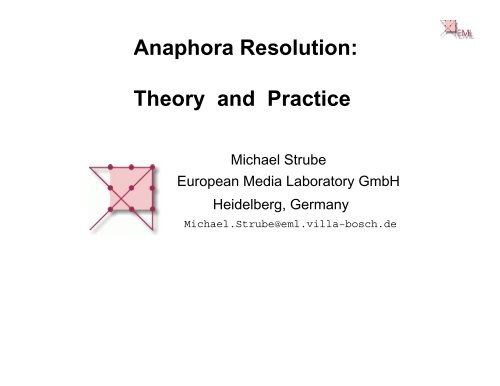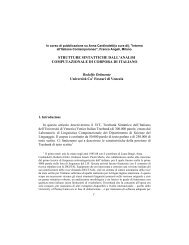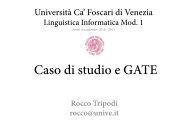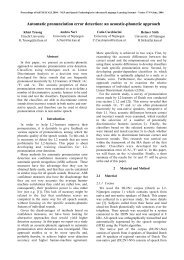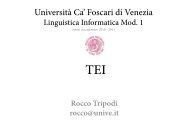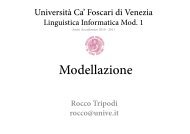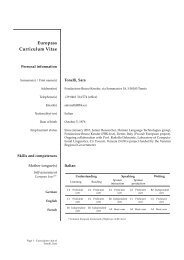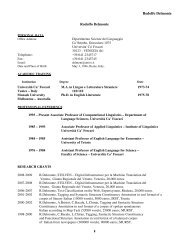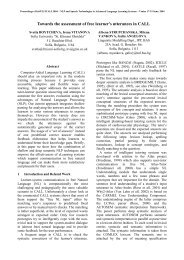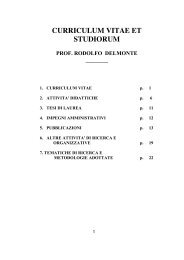Anaphora Resolution: Theory and Practice
Anaphora Resolution: Theory and Practice
Anaphora Resolution: Theory and Practice
You also want an ePaper? Increase the reach of your titles
YUMPU automatically turns print PDFs into web optimized ePapers that Google loves.
<strong>Anaphora</strong> <strong>Resolution</strong>:<strong>Theory</strong> <strong>and</strong> <strong>Practice</strong>Michael StrubeEuropean Media Laboratory GmbHHeidelberg, GermanyMichael.Strube@eml.villa−bosch.de
<strong>Anaphora</strong> <strong>Resolution</strong>:<strong>Theory</strong> <strong>and</strong> <strong>Practice</strong>Michael StrubeEuropean Media Laboratory GmbHHeidelberg, GermanyMichael.Strube@eml.villa−bosch.de
<strong>Anaphora</strong> <strong>Resolution</strong>:or<strong>Theory</strong> <strong>and</strong> <strong>Practice</strong>Michael StrubeEuropean Media Laboratory GmbHHeidelberg, GermanyMichael.Strube@eml.villa−bosch.de
A Few Questions• How do insights taken from centering-based models fare if they are appliedto large amounts of naturally occurring data?• How do centering-based models compare to corpus-based methods?Results? Coverage? Portability? Robustness? Development time?• What do centering-based models <strong>and</strong> corpus-based methods have incommon? What are the differences?
A Few Questions• How do insights taken from centering-based models fare if they are appliedto large amounts of naturally occurring data?• How do linguistic theories fare if they are applied to large amounts ofnaturally occurring data?• How do centering-based models compare to corpus-based methods?Results? Coverage? Portability? Robustness? Development time?• How do linguistic theories compare to corpus-based methods?Coverage? Portability? Robustness? Development time?Results?• What do centering-based models <strong>and</strong> corpus-based methods have incommon? What are the differences?⇒ What is our linguistic intuition good for?
Overview1. look back at Never look back;2. NLB applied to spoken dialogue;3. machine learning approach to reference resolution in text (how muchannotated data is needed to train an anaphora resolution classifier?);4. machine learning approach to pronoun resolution in spoken dialogue (whichfeatures do the work?);5. concluding remarks.
Never Look Back: An Alternative to Centering (NLB)Motivation:• centering accounts for intra-sentential anaphora by means of an appropriatedefinition of the utterance;• however, the utterance, which is the most crucial element in centering, is notspecified in the original literature (e.g. Grosz et al. (1995));• Kameyama (1998) presented an elaborate model on intra-sententialcentering; however, that model still cannot be applied to unrestricted data;• Kehler (1997) observed that centering is not cognitively plausible due to it’slack of incrementality.
NLB: The Model• (Discard most of the centering machinery.)• One construct: The list of salient discourse entities (S-list).• Two operations on the S-list:1. Incremental update: Insertion of discourse entities;2. Periodic elimination of discourse entites: Removing of discourse entitieswhich are not realized in the immediately preceding elimination unit.• S-list describes the attentional state of the hearer at any given point inprocessing a discourse.• Order among elements of the S-list directly provides preferences forinterpretation of pronouns.
NLB: The Algorithm1. If a referring expression is encountered,(a) if it is a pronoun, test the elements of the S-list in the given order until thetest succeeds;(b) update S-list; the position of the discourse entity associated with thereferring expression under consideration is determined by the S-listrankingcriteria which are used as an insertion algorithm.2. If the analysis of elimination unit U is finished, remove all discourse entitiesfrom the S-list, which are not realized in U.
NLB: The S-list Ranking• familiarity:OLDE U IMEDI C BN A BNNEW• linear order.
NLB: Results• results obtained by h<strong>and</strong>-simulation of the algorithm;• two languages: English <strong>and</strong> German (for each language about 600pronouns);• about 10% improvement in success rate over previous centering-basedapproaches (results confirmed by Tetrault (2001) who implemented asimplified version <strong>and</strong> compared that with a syntax-based version, whichdid even better).
NLB: Conclusions• pronoun resolution requires incremental update of the discourserepresentation <strong>and</strong> incremental resolution (I consider Tetrault’s (2001)results as confirmation of that point);• the incremental update helps to deal with pronouns with intra- <strong>and</strong>intersentential antecedents;• there is no need for centering constructs like backward-looking center,forward-looking centers <strong>and</strong> centering transitions;• (orthodox) centering may be a help for a lot of tasks in NLP, but definitely notfor pronoun resolution.
Application: <strong>Anaphora</strong> <strong>Resolution</strong> in Spoken Dialogue(Joint work with Miriam Eckert, formerly at UPenn, now at Microsoft)
Spoken Dialogue is Messy!B.57:A.58:B.59:-- what are they actually telling us, <strong>and</strong> after,you know, what happened the other day with that,uh, C I A guy, you know --Uh-huh.-- how much is, what all the wars we’re gettinginto <strong>and</strong> all the, you know, the messes we’re --A.60: That we really don’t --B.61: -- we’re bombing us, ourselves with --A.62: -- that we don’t know about,B.63: -- right, is that true, or, you know, is it,A.64: How much,B.65: is (( )),A.66: of it’s true, <strong>and</strong> how much --B.67: really a threat,A.68: -- <strong>and</strong> how much of it is propag<strong>and</strong>a --B.69: Right.(sw3241)
<strong>Anaphora</strong> <strong>Resolution</strong> in Spoken Dialogue: Problems• center of attention in multi-party discourse;• utterances with no discourse entities;• ab<strong>and</strong>oned or partial utterances (disfluencies, hesitations, interruptions,corrections);• determination of utterance units (no punctuation in spoken dialogue!);• low frequency of individual anaphora (NP-antecedents: 45.1%), but highfrequency of discourse-deictic (non-NP-antecedents: 22.6%) <strong>and</strong> vague(no antecedents: 32.3%) anaphora (data based on only three Switchboarddialogues).
Types of <strong>Anaphora</strong> I: Individual – 45.1%(IPro, IDem)(4) A: He i [McGyver]’s always going out <strong>and</strong> inventingnew things out of scrap [...]B: Boeing ought to hire him i <strong>and</strong> give him ia junkyard j , . . . <strong>and</strong> see if he i could build aSeven Forty-Seven out of it j .(sw2102)
Types of <strong>Anaphora</strong> II: Discourse-Deictic – 22.6%(DDPro, DDDem)(5) A: [The government don’t tell you everything.] iB: I know it i .(sw3241)(6) A: ...[we never know what they’re thinking] i .B: That i ’s right. [I don’t trust them] j ,maybe I guess it j ’s because of what happened over therewith their own people, how they threw them out of power...(sw3241)
Types of <strong>Anaphora</strong> III: Vague – 13.2%(VagPro, VagDem)(7) B.27 She has a private baby-sitter.A.28 Yeah.B.29 And, uh, the baby just screams. I mean, the baby islike seventeen months <strong>and</strong> she just screams.A.30 Uh-huh.B.31 Well even if she knows that they’re fixing to get readyto go over there. They’re not even there yet –A.32 Uh-huh.B.33 – you know.A.34 Yeah. It’s hard.
Types of <strong>Anaphora</strong> IV: Inferrable-Evoked Pronouns – 19.1%(IEPPro)(7) A: I think the Soviet Union knows what we have<strong>and</strong> knows that we’re pretty serious <strong>and</strong> if they ever triedto do anything, we would, we would be on the offensive.(sw3241)
Proposal for Pronoun <strong>Resolution</strong> in Spoken Dialogue I1. use update <strong>and</strong> elimination unit, but redefine elimination unit in terms ofdialogue acts (pairs of initiations <strong>and</strong> acknowledgements; acknowledgmentssignal that common ground is achieved);2. classify different types of anaphora using the predicative context of theanaphor;3. resolve individual <strong>and</strong> discourse-deictic anaphora.
Proposal for Pronoun <strong>Resolution</strong> in Spoken Dialogue IIClassification of different types of pronouns <strong>and</strong> demonstratives, so that• resolution of individual anaphora is only triggered if anaphor is classified asindividual (→ A-incompatible);• resolution of discourse-deictic anaphora is only triggered if anaphor isclassified as discourse-deictic (→ I-incompatible);
A-Incompatible (*A)x is an anaphor <strong>and</strong> cannot refer to abstract entities.• Equating constructions where a pronominal referent is equated with aconcrete individual referent, e.g., x is a car.• Copula constructions whose adjectives can only be applied to concreteentities, e.g., x is expensive, x is tasty, x is loud.• Arguments of verbs describing physical contact/stimulation, which cannot beused metaphorically, e.g., break x, smash x, eat x, drink x, smell x but NOT*see x
I-Incompatible (*I)x is an anaphor <strong>and</strong> cannot refer to individual, concrete entities.• Equating constructions where a pronominal referent is equated with anabstract object, e.g., x is making it easy, x is a suggestion.• Copula constructions whose adjectives can only be applied to abstractentities, e.g., x is true, x is false, x is correct, x is right, x isn’t right.• Arguments of verbs describing propositional attitude which only take S’-complements, e.g., assume.• Object of do.• Predicate or anaphoric referent is a “reason”, e.g., x is because I like her, xis why he’s late.
Overview of the AlgorithmA-/I-IncompatibleA-/I-IncompatibleynynI-/DDProindividual antecedent?I-/DDDemdiscourse-deictic antecedent?ynynIProdiscourse-deictic antecedent?DDDemindividual antecedent?ynynDDProVagProIDemVagDem
The Algorithm: Switchboard sw311728- I B.18 And [she ended up going to the University of Oklahoma].-28 A A.19 Uh-huh.S: [DAUGHTER: she, U. OF OKLA.: U. of Okla.]29-29 I B.20 I can say that because it was a big well known school,S: [U. OF OKLA.: it]A: [SHE ENDED UP . . . : that]30-30 I it had a well known education –S: [U. OF OKLA.: it, EDUCATION: education]
<strong>Anaphora</strong> <strong>Resolution</strong> in Spoken Dialogue: Summary• attempt to resolve anaphora in naturally occurring dialogue;• instead of ignoring words like uh-huh, yeah, . . . , we actually use them forrecognizing when common ground is achieved;• treatment of interruptions, hesitations, etc.;• achieve higher precision than ordinary anaphora resolution algorithms byclassifying different types of anaphors (baseline for individual anaphorawould be around 30%);• results published at EACL ’99, Amstelogue ’99, Journal of Semantics(17(1)).
Problems with These Approaches• only some of the features explicit; some of them hidden by the mechanism(algorithm); this is much worse with original centering;• there is only one S-list ordering; difficult to apply to different phenomena(e.g. pronouns vs. defNPs);• difficult to evaluate the contribution of each feature.
Proposal: Machine Learning for <strong>Anaphora</strong> <strong>Resolution</strong>• by applying ML-techniques we are able to determine more variables;• most features are explicit;• it is easy (though time-consuming) to determine the contribution of eachfeature; thus it is possible to decide whether it is necessary to includeexpensive features.
Application: <strong>Anaphora</strong> <strong>Resolution</strong> in Written Text(joint work with Stefan Rapp (Sony Research) <strong>and</strong> Christoph Müller (EML))• ACL ’02: Applying Co-Training to Reference <strong>Resolution</strong>• EMNLP ’02:<strong>Resolution</strong>The Influence of Minimun Edit Distance on Reference• is it possible to apply Co-Training (a weakly supervised machine learningmeta algorithm) to reference resolution?• German corpus (in the meantime applied to English as well with similarresults);• Co-Training did not work out that well (Ng & Cardie (2003, NAACL) reportbetter results);• however, by doing the Co-Training experiments we got interesting secondaryresults (reported at ACL ’02 <strong>and</strong> EMNLP ’02).
Features• NP-level features• coreference-level features
NP-level FeaturesDocument level features1. doc id document number (1 . . . 250)NP-level features2. ante gram func grammatical function of antecedent (subject, object, other)3. ante npform form of antecedent (definite NP, indefinite NP, personal pronoun,demonstrative pronoun, possessive pronoun, proper name)4. ante agree agreement in person, gender, number5. ante semanticclass semantic class of antecedent (human, concrete <strong>and</strong> abstract object)6. ana gram func grammatical function of anaphor (subject, object, other)7. ana npform form of anaphor (definite NP, indefinite NP, personal pronoun,demonstrative pronoun, possessive pronoun, proper name)8. ana agree agreement in person, gender, number9. ana semanticclass semantic class of anaphor (human, concrete object, abstract object)
Coreference-level FeaturesCoreference-level features10. wdist distance between anaphor <strong>and</strong> antecedent in words (1 . . . n)11. ddist distance between anaphor <strong>and</strong> antecedent in sentences (0, 1, >1)12. mdist distance between anaphor <strong>and</strong> antecedent in markables (1 . . . n)13. syn par anaphor <strong>and</strong> antecedent have the same grammatical function (yes, no)14. string ident anaphor <strong>and</strong> antecedent consist of identical strings (yes, no)15. substring match one string contains the other (yes, no)New coreference-level features16. ante med minimum edit distance to anaphorante med = 100 · m−(s+i+d)m17. ana med minimum edit distance to antecedentana med = 100 · n−(s+i+d)n
Different Results for Different Types of <strong>Anaphora</strong>(from EMNLP ’02)P R FdefNP 69.26% 22.47% 33.94%NE 90.77% 65.68% 76.22%PDS 25.00% 11.11% 15.38%PPER 85.81% 77.78% 81.60%PPOS 82.11% 87.31% 84.63%all 84.96% 56.65% 67.98%
Conclusions on <strong>Anaphora</strong> <strong>Resolution</strong> in Written Text• it is useful to train a separate classifier for each NP form;• we seem to be missing something with respect to defNP resolution:world/domain knowledge?• resolution of proper names is ok;• task of pronoun resolution in written text seems to be solved;• from the Co-Training experiments, we conclude that the amount of trainingdata required is surprisingly low.
Low Amount of Training Data for Pronouns0.90.80.70.60.50.40.3"20" using 2:9"20_0its" using 2:6"100" using 2:9"100_0its" using 2:6"200" using 2:9"200_0its" using 2:610 20 30 40 50 60 70 80 90 100
Amount of Training Data for <strong>Anaphora</strong> <strong>Resolution</strong>• for training a pronoun resolution classifier only 100-200 labeled instancesare needed;• for training classifiers for resolving proper names <strong>and</strong> definite NPs rather1000-2000 labeled instances are needed;• this may be due the fact, that pronoun resolution classifiers only rely on afew simple features.
Application: Pronoun <strong>Resolution</strong> for Spoken Dialogue(joint work with Christoph Müller (EML), ACL 2003)• test whether insights taken from the Eckert & Strube algorithm for pronounresolution in spoken dialogue work in a ML environment;• port the system (environment) from German written text to English spokendialogue;• what are the results for different types of anaphoric expressions?• determine which features contribute significantly to the results for each typeof anaphoric expression.
Hypotheses Derived from Previous Work• pronoun resolution in written text works reasonably well without consideringknowledge- or semantics-based features;• for determining non-NP-antecedents of pronouns domain knowledge seemsto be necessary (Byron, 2002);• Eckert & Strube (2000) had the hypothesis that information aboutsubcategorization frames of verbs gathered from corpora (e.g. Briscoe &Caroll (1997)) could be sufficient.
Data: Corpus• 20 r<strong>and</strong>omly chosen Switchboard dialogues;• 30810 tokens (words, punctuation) in 3275 sentences/1771 turns;• annotation consists of 16601 NP- <strong>and</strong> non-NP-markables;• identification of markables <strong>and</strong> assignment of attributes guided by PennTreebank;• 924 third person neuter pronouns: 43.4% have NP-antecedents, 23.6% non-NP-antecedents, 33% have no antecedents (almost identical to the numbersreported by Eckert & Strube, 2000).
Data: Annotation
Data: Distribution of Agreement Features for Pronouns3m 3f 3n 3pprp 67 63 49 47 541 318 418 358prp$ 18 15 14 11 3 3 35 27dtpro 0 0 0 0 380 298 12 11Σ 85 78 63 58 924 619 465 396• high number of singletons (223 for it, 60 for they, 82 for that);• these are either expletive or vague <strong>and</strong> do not have antecedents marked inthe corpus.
Data Generation for ML• pronoun resolution viewed as binary classification;• training <strong>and</strong> testing instances are pairs of potentially anaphoric pronouns<strong>and</strong> potential antecedents;• instances are labeled P if both markables have the same value in theirmember attribute, N otherwise;• pairs containing non-NP-antecedents restricted to cases where the pronounwas realized by it or that <strong>and</strong> the antecedent were non-NP-markables fromthe last two sentences.
Features• NP-level features;• coreference-level features;• features introduced for spoken language.
NP-level Features1. ante gram func grammatical function of antecedent2. ante npform form of antecedent3. ante agree person, gender, number4. ante case grammatical case of antecedent5. ante s depth the level of embedding in a sentence6. ana gram func grammatical function of anaphor7. ana npform form of anaphor8. ana agree person, gender, number9. ana case grammatical case of anaphor10. ana s depth the level of embedding in a sentence
Coreference-level Features11. agree comp compatibility in agreement between anaphor <strong>and</strong> antecedent12. npform comp compatibilty in NP form between anaphor <strong>and</strong> antecedent13. wdist distance between anaphor <strong>and</strong> antecedent in words14. mdist distance between anaphor <strong>and</strong> antecedent in markables15. sdist distance between anaphor <strong>and</strong> antecedent in sentences16. syn par anaphor <strong>and</strong> antecedent have the same grammatical function (yes, no)
Features for Dialogue17. ante exp type type of antecedent (NP, S, VP)18. ana np pref preference for NP arguments19. ana vp pref preference for VP arguments20. ana s pref preference for S arguments21. mdist 3mf3p distance in NP-markables22. mdist 3n distance in NP plus non-NP markables23. ante tfidf preference for important antecedents24. ante ic preference for important antecedents25. wdist ic distance is sum of IC of every word divided by number of words
Experimental SetupAnnotated CorpusCoreference setsData GenerationMachine Learning DataTrainingInstance SelectionKey ListTraining DataTest DataMachine LearningClassifierPredictionResponse ListEvaluation (Vilain)
Experimental Setup• CART decision trees (R reimplementation: RPART)(R was chosen because it turned out to be a flexible environment withoutloss in speed compared to specialized software);• all results reported obtained by 20-fold cross validation;• baseline: NP-antecedents only; features as used for pronoun resolution intext;• then iterative procedure applied for determining the best performingclassifier <strong>and</strong> its features.
Iterative Procedure(similar to wrapper approach for feature selection (Kohavi & John, 1997))1. start with a model based on a set of predefined baseline features;2. train models combining the baseline with all additional features seperately;3. choose the best performing feature; add it to the model;4. train models combining the enhanced model with each of the remainingfeatures separately;5. . . . repeat as long significant improvement can be observed.
Results: 3mfcorrect found total found total correctbaseline, features 1-16 120 150 1250plus mdist 3mf3p 121 153 1250precision recall f-measurebaseline, features 1-16 80.00 9.60 17.14plus mdist 3mf3p 79.08 9.68 17.25
Results: 3ncorrect found total found total correctbaseline, features 1-16 109 235 1250plus none 97 232 1250plus ante exp type 137 359 1250plus wdist ic 154 389 1250plus ante tfidf 158 391 1250precision recall f-measurebaseline, features 1-16 46.38 8.72 14.68plus none 41.81 7.76 13.09plus ante exp type 38.16 10.96 17.03plus wdist ic 39.59 12.32 18.79plus ante tfidf 40.41 12.64 19.26
Results: 3pcorrect found total found total correctbaseline, features 1-16 227 354 1250plus wdist ic 230 353 1250precision recall f-measurebaseline, features 1-16 64.12 18.16 28.30plus wdist ic 65.16 18.40 28.70
Results: Combinedcorrect found total found total correctbaseline, features 1-16 456 739 1250combined 509 897 1250precision recall f-measurebaseline, features 1-16 61.71 36.48 45.85combined 56.74 40.72 47.42
Discussionremaining problems:• features which are supposed to prevent the resolution of pronouns withoutantecedents are not effective;• identification of non-NP-antecedents difficult without semantic analysis;• definite NPs, proper names should be included as well;• binary classification is not optimal since the data contain to many negativecases (see Yang et al. (ACL 2003): competition learning approach);• evaluation!
Conclusions: ML for Pronoun <strong>Resolution</strong> in Spoken Dialogue• results comparable to Byron’s (2002) who assumes semantic analysis <strong>and</strong>domain (in-)dependent knowledge; she also does not consider all pronouns;• system ported successfully from anaphora resolution in written text topronoun resolution in spoken dialogue;• features derived from previous work do not work well, so, the theory did notkeep it’s promise.
Conclusions I• in my work on anaphora resolution the development of theories precedesthe implementation of systems;• the development of theories includes – <strong>and</strong> builds upon – the annotation ofcorpora <strong>and</strong> their descriptive analysis;• theories should always be tested against naturally occurring data, even ifonly h<strong>and</strong>-simulation is possible.
Conclusions IIHowever,• I used different corpora for the development of the theory <strong>and</strong> for evaluatingthe system;• theory <strong>and</strong> implemented system differ with respect to their expressiveness,coverage, evaluation methods;• many features which were important for the theory do not show up in thefinal ML classifier;• evaluation of the implemented system is much more rigorous.
Conclusions III• go beyond simple anaphora resolution in written texts;• distinguish between training <strong>and</strong> testing data;• report results according to accepted evaluation methods;• compare results to sensible baseline;• try to publish at ACL (the reviewer’s comments are usually very good).
Further Information (Papers, Annotation Tool, . . . )• http://www.eml.org• http://www.eml.org/nlp• http://www.eml.org/english/homes/strube• email: Michael.Strube@eml.villa-bosch.de


